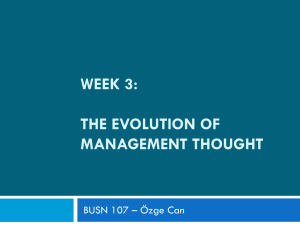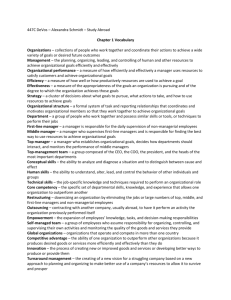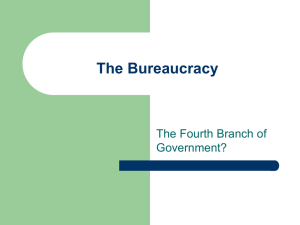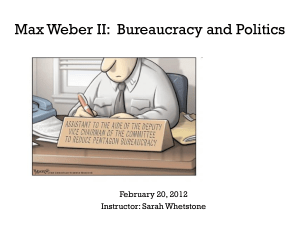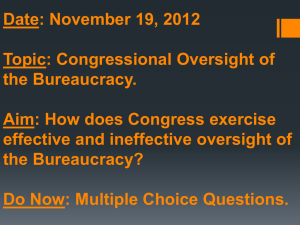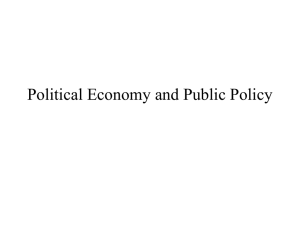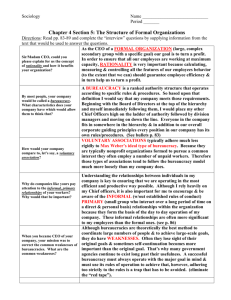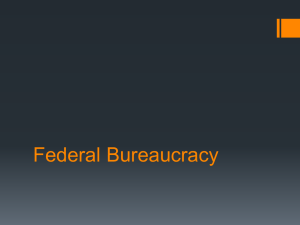Policy Implementation
advertisement
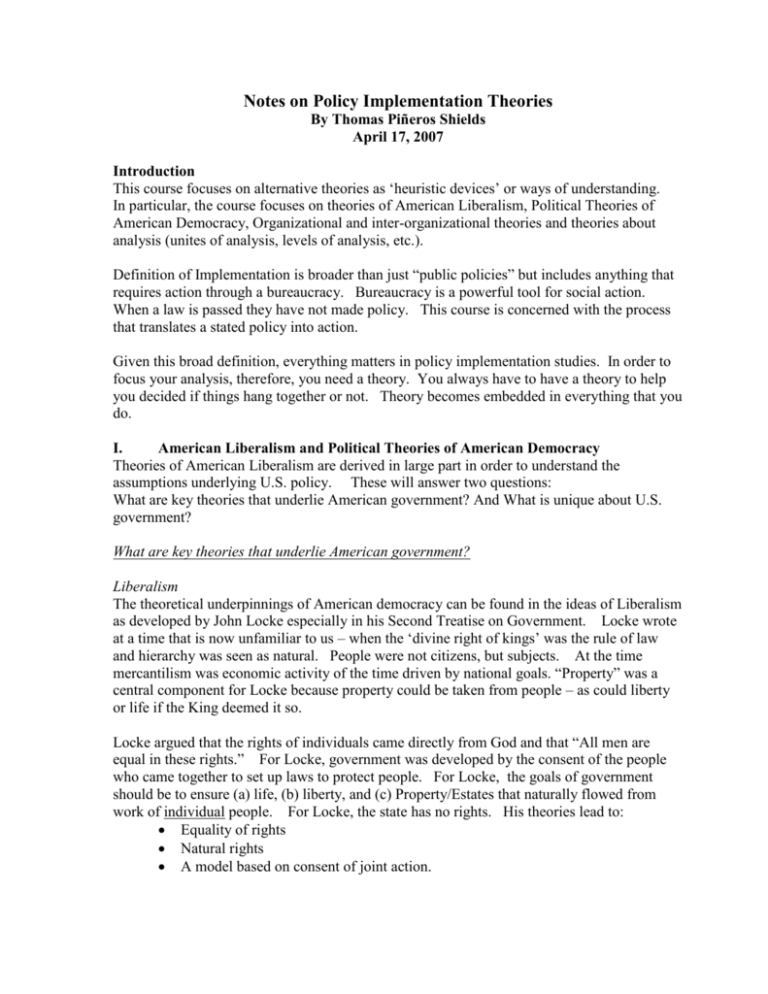
Notes on Policy Implementation Theories By Thomas Piñeros Shields April 17, 2007 Introduction This course focuses on alternative theories as ‘heuristic devices’ or ways of understanding. In particular, the course focuses on theories of American Liberalism, Political Theories of American Democracy, Organizational and inter-organizational theories and theories about analysis (unites of analysis, levels of analysis, etc.). Definition of Implementation is broader than just “public policies” but includes anything that requires action through a bureaucracy. Bureaucracy is a powerful tool for social action. When a law is passed they have not made policy. This course is concerned with the process that translates a stated policy into action. Given this broad definition, everything matters in policy implementation studies. In order to focus your analysis, therefore, you need a theory. You always have to have a theory to help you decided if things hang together or not. Theory becomes embedded in everything that you do. I. American Liberalism and Political Theories of American Democracy Theories of American Liberalism are derived in large part in order to understand the assumptions underlying U.S. policy. These will answer two questions: What are key theories that underlie American government? And What is unique about U.S. government? What are key theories that underlie American government? Liberalism The theoretical underpinnings of American democracy can be found in the ideas of Liberalism as developed by John Locke especially in his Second Treatise on Government. Locke wrote at a time that is now unfamiliar to us – when the ‘divine right of kings’ was the rule of law and hierarchy was seen as natural. People were not citizens, but subjects. At the time mercantilism was economic activity of the time driven by national goals. “Property” was a central component for Locke because property could be taken from people – as could liberty or life if the King deemed it so. Locke argued that the rights of individuals came directly from God and that “All men are equal in these rights.” For Locke, government was developed by the consent of the people who came together to set up laws to protect people. For Locke, the goals of government should be to ensure (a) life, (b) liberty, and (c) Property/Estates that naturally flowed from work of individual people. For Locke, the state has no rights. His theories lead to: Equality of rights Natural rights A model based on consent of joint action. But, we study Locke because “Locke lives!” Federalism The Federalist Papers (especially those written by James Madison) argued in favor of the constitution They were written after the American Revolution as propaganda to support the Constitution. The Articles of Confederation which lacked security, debt, trade were too fluid and ineffective. Federalists make a case for government that is effectively ‘against government.’ “The government is best that governs least.” A central concern of federalists is that any concentration of power leads to tyranny. Usually, we assume that tyranny refers to minority control over the majority – but the federalists were concerned with the tyranny of the minority over individual and natural rights. So, how can a government not tyrannize: 1. Separate the functions of government. 2. Combine nationalist/federalist government to allow ‘partial agency’ (no one part of government can do anything alone). 3. Legislative was seen as the most powerful branch – so it needed to be divided into two houses. 4. Each part of government was elected in a different way. States were given authority to get things done not allowed by the federal government. Bureaucracy replicates the model of partial authority/agency seen above. Pluralism Pluralism emerged from the Federalist model of government. The goal of the federalist government was that no faction could dominate. Factions were based on economic interests and are understood today to be ‘interest groups.’ The government’s role is to mediate between the sum of multiple interest groups. Pluralists (ex.- Theodore Lowi) believe we should turn society over to interest groups What is Unique about American government? American particularism looks at how America’s political model does not coincide with Europe’s model. Louis Hartz in The Liberal Tradition spells out the secular myth of American particularism in which governments evolved out of a dialectic tension between stages and new stages. In Europe: Natural progression occurred : Feudal societies (Birth determines place in society) Liberal (Society built around ideas of individual rights) Capitalism needed to be defended from the left Socialism (Grew out of tension between feudal society and liberal) In colonial societies (the United States) Absence of feudalism meant no tension Liberalism was institutionalized so U.S. policies needed to be defined within the liberal tradition. American’s social, economic and political thought are ubiquitously liberal. During the Great Depression, capitalism needed to be defended from the right. Critique of Hartz by Rogers Smith Race and gender missing from Hartz’s discussion. o Race: For Hartz, racism was a residual category of the past and that the U.S. will stay on the same course and grow out of racism. Smith, however, does not assume any directionality of progress. o Gender: Smith is less clear than he was on race. There is no one trajectory for the evolution of government. For Smith, there is ‘ascriptive’ assignment to social groups built into American political, social and economic system, which contradicts the notions of individualism within the Liberal tradition. This justifies the idea of compensatory benefits for groups such as children, people with disabilities, maternity, affirmative action, etc. o Children: “The Rights of the Child” include required immunization, mandatory schooling and they can’t vote because we see children as dependent. o Civil Rights movement in the U.S. was an attempt to overcome ascriptive rights. Smith notes that the Founding Fathers intentionally excluded some groups and differentiated rights among people within U.S. society. Gosta Esping-Anderson Esping-Anderson starts with a definition of the welfare state. He rejects that welfare state based on total expenditures (b/c in the U.S. most financial spending is at the state level). He calls the process “De-commodification” by which people live outside of the market. The liberal view is that people who are dependent on government are free to enter the market. Esping-Anderson argues that people are dependent on both the market and government. Esping-Anderson proposes three models of the welfare state 1. Safety net model. “Poor relief” 2. Social Protection Model. “Social insurance” such as social security, Medicare, etc. as found in Scandinavian countries. 3. Beveridge type/Social Democratic model – Universalist equal benefits to all. There is not ‘directionality’ in these approaches/models. III. Theories of Government: Institutions That Play a Role In this next section, the course builds on the federalist model and reviews the different institutions of government that are inherently in conflict with each other. These theories seem to draw from a number of sources and cover a number of theories. There are several readings, but the central text throughout this section is Martha Derthick’s Agency Under Stress. a. The Role of Leadership and the Executive The Executive plays two roles: 1. Policymaking roles 2. Administrative head Why do executives focus more on policy making than implementation? 1. Executives do not expect much to happen in the time allowed 2. Policy making is more exciting. What happens afterwards gets relegated to ‘public administration’ 3. Executives are elected based on policies 4. Implementation requires different skills Traditional Approaches to Implementation Rationalizing (Getting More Done!) Making policy more efficient, which usually means more control from the top. Who in fact ‘runs’ the bureaucracy? The president – yes, but no. ….share authority with congress How does Executive run the bureaucracy? i. Budget 1. Sets priorities 2. Builds incentives and punishments ii. Appointments 1. Political Appointees/Friends (Jacksonian Democracy) 2. Civil Servants iii. Structure and organization Why do people follow? i. People want to follow leaders ii. People accept bureaucratic authority. Why? 1. Socialized to follow 2. The authority can punish 3. The authority can reward 4. Hierarchy/position is seen as legitimate MacGregor Burns Leadership Burns describes alternative authority structures especially for professionals. Professional authority is based on knowledge and knowledge criteria Competing interests exist. A leader brings some interests forward and others back to serve the leaders’ goals. Hugh Heclo, Both Ends of the Avenue Changing nature of policy to make it more difficult for leadership to direct bureaucracy Congestion and intrinsic complications All policies affect all other models so therefore, there are conflicting goals and mobilization of interest groups. Policies mobilize interest groups based on a shared authority to multiply veto groups. Heclo looks at Reagan’s success based on his ability to narrow and simplify goals and a desire to do less - to stop action – which can be easier than to start/initiate action. b. Legislation and Interest Groups Control over the bureaucracy (government agencies) is shared. Legislative (Congress) Legislation Appointment appeal Set the number of people Budget Authorization (Create and change programs) Budget Appropriation (Give programs money to make it so) Investigations. Executive (President) Budget Appointments Structure and organization Congress is on patrol – they follow and monitor agencies. Also, they respond to public outcry. Federalism and Interest Groups See Federalist Papers #10. Madison argues that we need to control the effects of factions to protect property. Capture : When legislation becomes controlled by interest groups. Iron Triangle: Interest Groups, Congressional committees and Administrative Offices conspire to affect legislation. This used to be the dominant theory. Policy Networks. Policy networks define who is valued in influencing policy. These include congress, administration, interest groups, academia. The nature of legislation is that it is difficult to implement. Some reasons include: a. Ambiguity and vague – to get it passed. b. Details and specifics are imposed to ensure accountability c. Timelines can be too tight d. Administration may be unavailable e. Administrative tasksa re not a priority f. Congress changes it’s mind g. Congress is the policy maker and constituent server, so it delegates administration. c. States and Federalism Federalism: of or formed by a compact. The definition is “a union of states in which each agrees to subordinate its authority to a central power.” Types of federalism a) Federal and State Governments are separate. This is not realistic. b) “Marble cake” Federalism. Both federal and state governments are active in similar work, therefore they compete or cooperate. The overlapping jurisdiction will complicate implementation. Federalism debate exists around how powerful government should be. There is tension between states and federal governement. Rights not in the constitution are left to the states. BUT clauses on ‘general welfare’ and ‘common defense’ allow the federal government to do what is necessary. Debate began in the constitutional convention. When Hamilton created the national bank Jefferson and Madison were frightened. Tocqueville saw two governments that were separate and independent. Lincoln in the Gettysburg Address claimed that the Union created the states – and thereby flipped the padigm. Progressive Era through the New Deal – led to an “Economic declaration of Rights” by FDR. This was in contrast to Jefferson and Jackson ideas of democracy which needed to be guarded from the governmental intrusion. Post World War II there was growth and optimism in government. Then, JFK assassination, RFK assassination, MLK assasinatin, riots and Vietnam. Benefits of Centralization Efficiency (some would say this is not true) Consistency Uniformity Transparency/tracking Monitoring is easier Quality control Equity and opportunity for distribution Principal-Agency Theory: CLARIFICATION Benefits of De-Centralization Better target Meet diverse needs Responsive to variation Individual influences Less bureaucracy More responsive/quicker One group acts on behalf of another. *** NEED d. Courts and American System Federalist Papers #78 by Hamilton the courts are weak The Courts protect the constitution from the Congress. The constitution is “the people” Shep Melnick, Between the Lines The job of the court is to interpret congressional laws How do courts make decisions? o Constitutional (Ammendments) o Statutory Interpretation – Judges interpret made to enforce decisions and resolve dispute between executive branch and a person with standing. o “A person with standing” Interest groups and people who are affected o Courts do not bring costs or agency plans into consideration. Court process is complex and convoluted. Politics does not end when a law is passed. IV. Classic Theories of Bureaucracy a. Max Weber: Foundational view of bureaucracy b. Woodrow Wilson: Applies Weber’s vision to modern American administration c. J.Q. Wilson, Bureaucracy” Overview of more recent thinking on bureaucracy in response to older thinking’s failure to take into account how things really work. d. Crozier: French bureaucracy raises questions about the limits of generalization. Weber on Bureaucracy Weber presents an ‘archetype’ of process(bureaucracy). For Weber, Bureaucracy is a process-oriented system of written rules, paid positions, impersonal, hierarchy with specialized division of labor. Key is that people in a bureaucracy act as a ‘role.’ Goal displacement : The organization’s goal is one thing. “Operators” goal is to follow the rules, etc. The bureaucrat’s role is to implement the rules. The bureaucrat is loyal to the process and the organization itself. For Weber, Bureaucracy operates mechanically. Why do people comply with a bureaucracy? Coercion of rules: Benefits and salaries was not the most important piece for Weber. People comply when/if they believe that authority is legitimate and accepted. Authority is power that you do not have to ‘enforce’ or ‘exercise” Why wouldn’t people comply? Bureaucracy works: o Speed o Precision o Efficiency o o o o Knowledge Controllability Continuity/Predictability Consistent and equal treatment (This is not the same as fairness or justice. Ex.Hitler’s regime called “the banality of evil” by Hannah Arendt “Bureaucracy is the only way we know how to transform policy into social action” – J. Prottas Problems with Bureaucracy Not very good at dealing with individual difference Inability to change direction Inability to cross boundaries Woodrow Wilson Builds on Weber Professional public administration sought to separate politics from administration. Professional public administration is machinery and politics decides what to use machine to make. James Q. Wilson Critique of Weber: You cannot explain modern outcomes with Weber or W. Wilson. Two components: o Administrative component o Political component JQW Argues: You cannot distinguish between politics and bureaucracy Bureaucracy is a political organization o Incentive systems. Separate from substance of the agency. Takes away from the incentive controls on behavior. o Contextual goals. Separate from substantive goals of the organization. Ex.: EPA substantive goal is to protect the environment. Other goals include respect for due process, hiring constraints, transparency, etc. Profit vs. Non Profit organizations o For-profit organizations = one test for success (the bottom line) o Non-profit organizations = Multiple tests of success o Role of the NPO executive: leadership and implementation are closer o Clientele in for profit are willing to pay and participate in services; in NPO the clients may not be willing o Multiple statkeholders is a big issue for public organizing Non-profit organizations: Exit, Voice and Loyalty by Hrischman o What do people do when they are unhappy with what someone is doing? Exit: Easier for private companies Voice: Very difficult for managers to deal with Loyalty – give in to what the organization wants Four Kinds of Bureaucracies (JQ Wilson, Ch. 9) Compliance (Process is followed?) Observability (Results are Measured?) Production Agencies Ex. – IRS, SSA Top-down Yes No Yes Procedural Agencies Ex.- Army in peace time; Safety inspectors No Craft Agencies Ex.- Army in war, Corps of Engineers Coping Agencies Ex. – Police; classroom teachers Garbage Can Theories: People do not search for the best solution. Insteead they suearch for an adequate solution that is satisficing rather than optimizing. People start searches from within their existing routines The search for the solutions and the search for problems go together. V. Levels of Analysis Essence of a Decision by Graham Allison Model I. Rational Actor Model (RAM): Rationality refers to own likely actions following logical assumptions. Model II. Organizations Análisis: Unit of anlysis of organization includes many levels that come up with routiens and plans they arleady have. Predictability and routine are important for producing predicted outputs. Model III. Government political process. Policies decisions are the results of interorganizational bargaining. The study of implementation becomes a sub-set of the study of power and influence. VI. Implementation and Theoretical Frameworks This part of the course looks at how we study ‘implementation’? Mazmanian and Sabatier Set limits on what implementation studies are and are not. Distinguishes from program evaluation. Examines the outputs, impacts and outcomes of public policies. Also different from policy formation. Statutory Congruence Model: To what extent does policy as implemented vary from a standard (stated policy) as passed. This is a top down model that builds off of W.Wilson’s approach of professional public administration. I. Variation in Policy Types 1. Redistributive policies 2. Distributive policies 3. Regulatory policies II. Problem tractability 1. who is affected? 2. Nature of change 3. Percent of population 4. Technical difficulties III. Nature of policy/Statute 1. Is it clear? 2. Is it consistent? 3. Can we incorporate a causal theory? IV. Causal Theory 1. What is the causal theory of the policy? What is it expected to accomplish? (IF X strategy then Y outcomes) 2. Not unlike the rational actor model VII. Alternative Frameworks Hassenfeld and Brock Present domains where explanations might be formed I. Political Economy Model a. Policy Outputs in target population b. Policy making c. Policy instruments (authority, program design, resources) II. Critical Actors III. Driving Forces VIII. Bottom Up and Social Network Approaches Social Exchange Theory: ‘exchange” of information, etc. Giving something in order to get something. The Idea of Street Level Bureaucracy A goal of the worker is autonomy. The worker seeks different goals than the boss. Outside of the hierarchy there are other social exchanges based on friendliness, turst, shared destiny, mission, etc. Social Exchange theory demands that we look at other non-monitary thigns that are valued and exchanged. Network Approaches A network model is a semi-closed system and is not dyadic Routines are a way of coordinating efforts and communicating what the world is like. Boundary actors operate on the edge of organizational/bureaucratic systems and the external networks. o Types of Boundary Actors Street Level Bureaucrats are a type of boundary actor. Top boundary actors Buyers Accountants Matland Conflict/Ambiguity Model Adapted and applied by M.Doonan Conflict Low Ambiguity Low Administrative High High Political Use a modified top-down approach to study resources. Use a modified top-down approach to study power. Experimental Symbolic Use a bottom-up approach to study context. Use a bottom-up approach to study coalition strength – or don’t study it. Cline Defines the problem of implemnation study as hwo you define the policy problem. 1. Communication model (CM): It assumes interests are not in conflict. Want to find remedy to conflict. Conflict is illigeimate and a management problem. (Weber and W.Wilson) 2. Implementation Regime Framework (IRF). Regime has norms, rules na procedures. IRF defines problem of implementation as eliciting cooperation despite conflict. It achieves cooperation. IX. Inter-Organizational Theories Do we conceive of a series of dyadic relationships or a network of inter-relationships? Soafer and Myrtle: Interorganizational Theory (IOR) Exchanges are necessary to organization resources Builds off of Open Systems Theory Mitchell and Shortell: Environment Strategies Capabilities Looks at Community Health Programs (CHPs) in How to map a network: 1. 2. 3. Who is in the network? (roles) What are they sharing (currency of exchange)? What are the terms of sharing? (Rules of exchange?) 4. 5. How do they make it work? (Norms, rules, processes?) How do they assess success? Equity of didactic exchange Outcomes/Reach goals Ostrom: Institutional Analysis and Development (IAD) Framework Assume actors are rational and maximizers but bounded by limited information.
